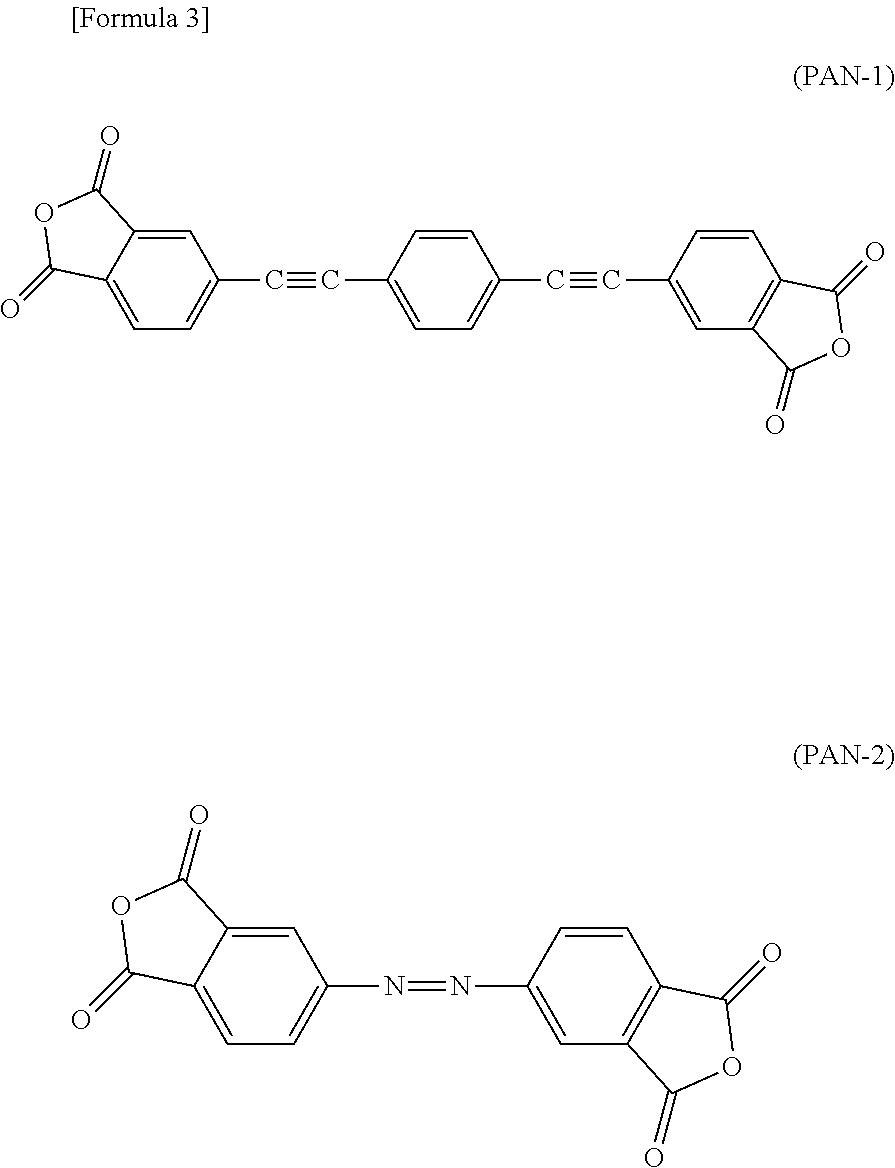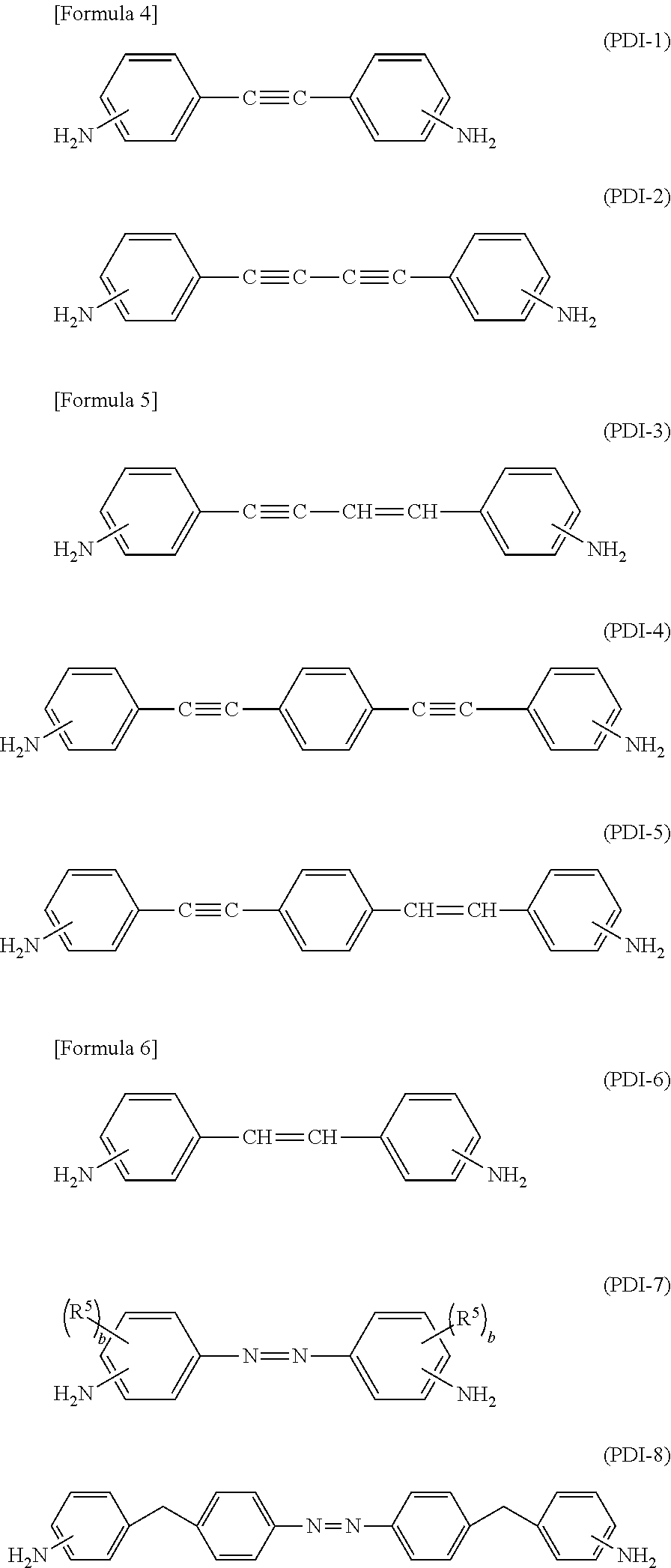Liquid crystal display element and method for manufacturing same
a technology of liquid crystal display element and liquid crystal, which is applied in the direction of instruments, coatings, chemistry apparatuses and processes, etc., can solve the problems of deteriorating display performance, insufficient increase of aperture ratio, and display defects, and achieve good alignment stability and improved image sticking characteristics
- Summary
- Abstract
- Description
- Claims
- Application Information
AI Technical Summary
Benefits of technology
Problems solved by technology
Method used
Image
Examples
synthesis example 1
[0345]0.2102 g of diamine (DI-5-1, m=2), 0.0664 g of diamine (DI-9-1), 0.2082 g of diamine (PDI-6-1), 0.5778 g of diamine (PDI-7-1), and 18.5 g 50 mL of dehydration NMP were put in a brown four-necked flask equipped with a thermometer, a stirrer, an inlet for feeding a raw material, and another inlet for introducing nitrogen gas and then stirred and dissolved under a dry nitrogen stream. Subsequently, 0.1268 g of acid dianhydride (AN-1-13), 1.8106 g of acid dianhydride (AN-4-17, m=8), and 18.5 g of dehydrated NMP were added thereto and continuously stirred at room temperature for 24 hours. Then, 10.0 g of BC was added to the reaction solution, obtaining a polyamic acid solution having a polymer solid concentration of 6 wt %. This polyamic acid solution is called PA1. A weight average molecular weight of the polyamic acid included in the PA1 was 39,400.
synthesis examples 2 to 8
[0346]As shown in Table 1, polyamic acid solutions PA2 to PA8 respectively having a polymer solid concentration of 6 wt % were prepared according to the same method as Synthesis Example 1, except for changing the tetracarboxylic dianhydride and the diamine. Table 1 shows the weight average molecular weight results of the obtained polyamic acids as well as the result of Synthesis Example 1.
TABLE 1SynthesisPolyamicTetracarboxylicWeight averageEx. No.acid No.dianhydride(mol %))Diamine(mol %)molecular weight1PA1AN-1-13 (10)DI-5-1 (m = 2)(20)39,400AN-4-17 (m = 8) (90)DI-9-1 (5)PDI-6-1(20)PDI-7-1(55)2PA2AN-3-1 (30)DI-5-1 (m = 2)(50)42,000AN-4-17 (m = 8) (70)PDI-7-1(50)3PA3AN-4-17 (m = 8)(100)DI-5-1 (m = 4)(40)32,000PDI-7-1(60)4PA4AN-4-21(100)DI-5-1 (m = 4)(25)21,700PDI-7-1(75)5PA5AN-4-21(100)DI-5-4(50)28,600PDI-7-1(50)6PA6PAN-2(100)DI-2-1(20)40,700PDI-7-1(80)7PA7AN-4-17 (m = 8)(100)DI-19-7(R41═C7H15) (3)17,500PDI-7-1(97)8PA8AN-4-17 (m = 8)(100)DI-4-13(10)15,200DI-16-5(R35═C5H11) (5)PDI-7-...
synthesis example 9
[0348]0.7349 g of diamine (DI-4-1) and 18.5 g of dehydration NMP were put in a brown 50 mL four-necked flask equipped with a thermometer, a stirrer for feeding a raw material, and another inlet for introducing nitrogen gas and then stirred and dissolved under a dry nitrogen stream. Subsequently, 0.6732 g of acid dianhydride (AN-1-1), 1.5918 g of acid dianhydride (AN-4-28), and 18.5 g of dehydrated NMP were added thereto at room temperature and continuously stirred for 24 hours. Then, 10.0 g of BC was added to the reaction solution, obtaining a polyamic acid solution having a polymer solid concentration of 6 wt %. This polyamic acid solution was called PA9. A weight average molecular weight of the polyamic acid included in the PA9 was 51,000.
PUM
| Property | Measurement | Unit |
|---|---|---|
| dielectric anisotropy | aaaaa | aaaaa |
| electric field | aaaaa | aaaaa |
| photoisomerization structure | aaaaa | aaaaa |
Abstract
Description
Claims
Application Information
 Login to View More
Login to View More - R&D
- Intellectual Property
- Life Sciences
- Materials
- Tech Scout
- Unparalleled Data Quality
- Higher Quality Content
- 60% Fewer Hallucinations
Browse by: Latest US Patents, China's latest patents, Technical Efficacy Thesaurus, Application Domain, Technology Topic, Popular Technical Reports.
© 2025 PatSnap. All rights reserved.Legal|Privacy policy|Modern Slavery Act Transparency Statement|Sitemap|About US| Contact US: help@patsnap.com



